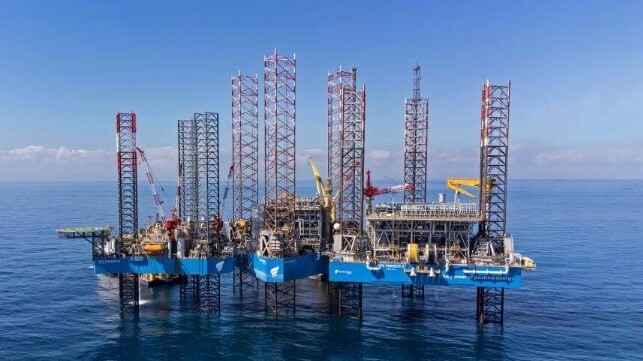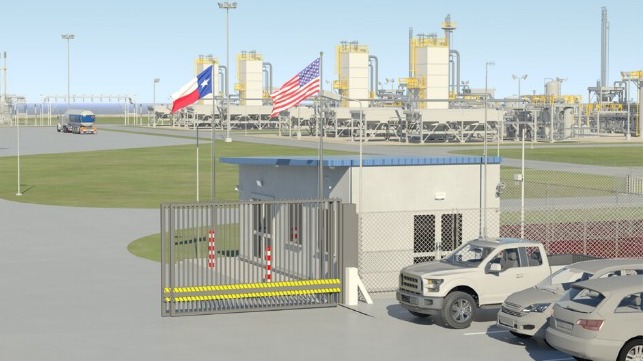CBP Lets Foreign-Flag Ships Move U.S. Natural Gas to Puerto Rico
U.S. gas is a foreign cargo if processed and liquefied in Mexico first, CBP rules

U.S. Customs and Border Protection will allow foreign-flag LNG carriers to move U.S. gas to U.S. markets, without violating the Jones Act, according to New York-based New Fortress Energy. The company has secured a CBP ruling for the operations of its Mexico-based LNG plant, which will process, liquefy and ship U.S.-origin natural gas to Puerto Rico.
“We are extremely pleased to receive this ruling for our FLNG facility since it not only supports one of the company’s largest projects but also supports the people of Puerto Rico,” said Wes Edens, Chairman and CEO of New Fortress Energy.
Fast LNG 1 represents a new model of liquefaction terminal development. The plant was constructed aboard three jackup rigs at a shipyard, then moved out to a permanent location off Mexico and installed. It received its first gas from Texas via a pipeline late last year.
The natural gas feedstock for Fast LNG 1 comes from the largest U.S.-to-Mexico export pipeline, Valley Crossing / Sur de Texas. The line was built in the late 2010s to connect "reliable, plentiful Texas supply with growing Mexican demand," according to midstream company Enbridge. The gas enters the pipeline in the Agua Dulce area, a collection and distribution hub near Corpus Christi.
New Fortress' plant will receive this U.S. natural gas, treat and liquefy it, then load the product onto foreign-flag LNG carriers. The LNG carriers will deliver the product to Puerto Rico, the company says, where it will be regasified and used.
Because the U.S. mainland and Puerto Rico are both U.S. points, U.S.-based LNG plants would have to use U.S. vessels qualified for coastwise transport to carry out this trade. Jones Act-qualified full size LNG carriers do not currently exist, so U.S.-based LNG plants sell all full size cargoes to foreign customers.
However, the Jones Act does not apply to LNG plants located in Mexico, according to CBP, even if the gas is the same. The agency has ruled that Fast LNG 1 can freely use foreign-flag, foreign-crewed LNG carriers to transport U.S. pipeline gas from Texas to Puerto Rico via liquefaction south of the border. The agency determined that when the gas is treated and liquefied at the plant in Mexico, it will become "different from the pipeline feed gas" that departed Texas; since it has been modified, it is no longer a U.S. cargo, by the agency's reasoning.
According to CBP, Fast LNG 1's facility will remove and burn the heavier fractions found in pipeline gas - ethane, propane and butane - before compressing and chilling the remaining 95 percent of the feedstock, methane. When the LNG is regasified in Puerto Rico for use, it will still meet the market definition of "natural gas" - but it will lack the condensate fractions removed in Mexico, and will have a slightly lower heat value. Because of this modification, it will be a "new and different product from the [U.S.] pipeline feed gas," not a U.S. cargo, and legally permissible to move on a foreign-flag ship, CBP determined.
New Fortress did not respond to multiple requests for comment.
U.S. maritime sources suggested that the industry as a whole is still digesting the ruling, but some expressed unease. "The Jones Act clearly precludes foreign vessels from engaging in 'any part of the transportation' between two U.S. points," one source commented.
New Fortress has deep ties to Puerto Rico's LNG supply chain, including a floating LNG terminal project that has been delayed by a permitting dispute with the Federal Energy Regulatory Commission (FERC). The company also holds a contract with Puerto Rico's power authority to operate a fleet of 12 gas-fired powerplants fed by LNG; the power authority's union has sued to block the contract from taking effect.
Galveston LNG Bunker Port Sets Site for Proposed LNG Bunkering Facility
Provide Clean Fuel to the Maritime Industry in the Greater Galveston Bay Area
LNG IS NOT CLEAN NOR GREEN

Galveston LNG Bunker Port (GLBP) has announced its lease-agreement with the City of Texas City for 140 acres of land on Shoal Point in Galveston County, Texas, adjacent to the Texas City Ship Channel and in close proximity to the maritime centers of Texas City, Galveston, and Houston.
Galveston LNG Bunker Port is a Joint Venture between Seapath and Pilot LNG to develop, construct, and operate the US Gulf Coast’s first dedicated facility supporting the fueling of LNG-powered vessels and will be located on 140 acres of prime deep-water marine industrial real estate in Galveston County, Texas. GLBP was announced in September of 2023 as a joint-venture between Seapath Group (Seapath), a maritime subsidiary of Libra Group, and Pilot LNG, LLC (Pilot), a Houston-based clean energy solutions company. Pilot and Seapath anticipate announcing the Final Investment Decision (FID) details of the GLBP project on Shoal Point by the second half of 2024, with operations commencing in late 2026.
Texas City Mayor, Dedrick Johnson says: “Texas City is excited to be partnering with GLBP to develop Shoal Point. Shoal Point and Texas City are an integral part of the maritime economy both in the State of Texas and throughout the U.S. We are very happy to have GLBP in our City and look forward to the jobs and economic opportunities that the project will bring to Texas City.”
Jonathan Cook, CEO of Pilot LNG stated: “GLBP is fortunate to have a collaborative partner in Texas City, and we believe this is the best possible site in the entire Galveston Bay region for our clean energy facility. Its strategic location and proximity to the key ports of Texas City, Galveston, and Houston is critical in ensuring the successful delivery of this LNG marine fuels project. We look forward to more announcements in the coming weeks and months as additional milestones are achieved towards the successful delivery of the project.”
Since the project was announced in September, GLBP has assembled a top team of advisors and continues its ongoing front-end engineering and design development for the project. The project as designed is for a two train and two tank facility producing 600,000 gallons per day. The first phase of the GLBP project is expected to produce 300,000 gallons per day of LNG for sale into the marine bunker fuel market in the Galveston Bay, and Western Gulf of Mexico region. GLBP estimates it will file applications with the necessary federal and state agencies to permit, construct, and operate the small-scale LNG terminal for marine fuel in early 2024.
This article is sponsored by Seapath. For more information on the LNG project visit www.galvestonlng.com
No comments:
Post a Comment